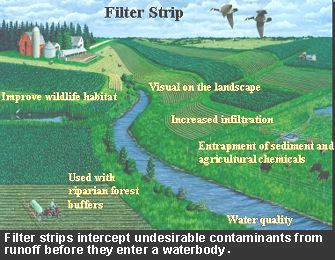Core Principle 4: Conservation Buffers - Filter Strip
A filter strip is an area of grass or other permanent vegetation used to reduce sediment, organics, nutrients, pesticides, and other contaminants from runoff and to maintain or improve water quality. Filter strips intercept undesirable contaminants from runoff before they enter a waterbody. They provide a buffer between contaminant sources, such as crop fields, and waterbodies, such as streams and ponds. Filter strips slow the velocity of water, allowing the settling out of suspended soil particles, infiltration of runoff and soluble pollutants, adsorption of pollutants on soil and plant surfaces, and uptake of soluble pollutants by plants. The mechanisms of filter strip function can vary according to the characteristics of a pollutant. Secondary benefits of filter strips may also include:
- Forage - for farm use or as cash crop
- Field borders
- Turnrows and headlands
- Access
- Aesthetics
Filter strips apply to lower edges of cropland fields where contributions of pollutants may move off the cropland area. They can also be used above conservation practices, such as ponds, drainageways, and terraces, to reduce the load of sediment and other contaminants moving into the practice areas. The slope of the filter and the soil of the filter area impact the overall performance. Steeper slopes increase flow velocity and shorten the time the contaminant material carried in the runoff, both particulate and soluble, has an opportunity to interact with the vegetation and soil in the filter area. In most filter systems the greater the flow length (filter width) of filter area provides the greater entrapment and removal of contaminants. Most practical designs are based on contaminant removals of more than 50 to 60 percent.
Operation and maintenance requirements for filter strips are minimal. To allow proper functioning and performance, it is recommended that maintenance include the following:
- Provide for shallow, sheet flow into the filter
- Repair rills and redirect concentrated flow
- Remove sediment accumulations
- Harvest biomass
- Control weeds
- Integrate other conservation practices
![[logo] US EPA](https://www.epa.gov/epafiles/images/logo_epaseal.gif)
